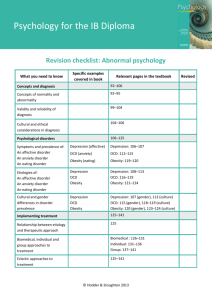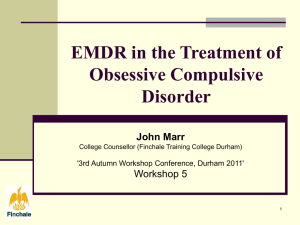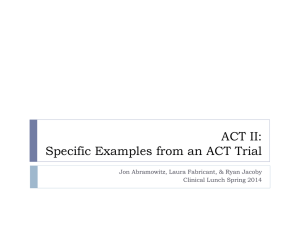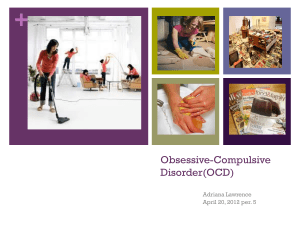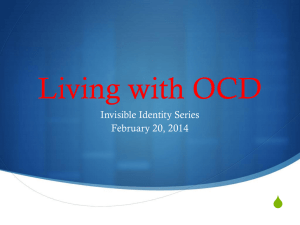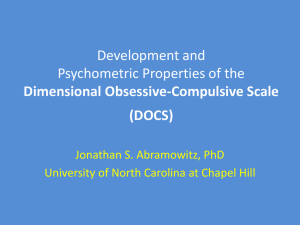261-786-1-RV - ASEAN Journal of Psychiatry
advertisement
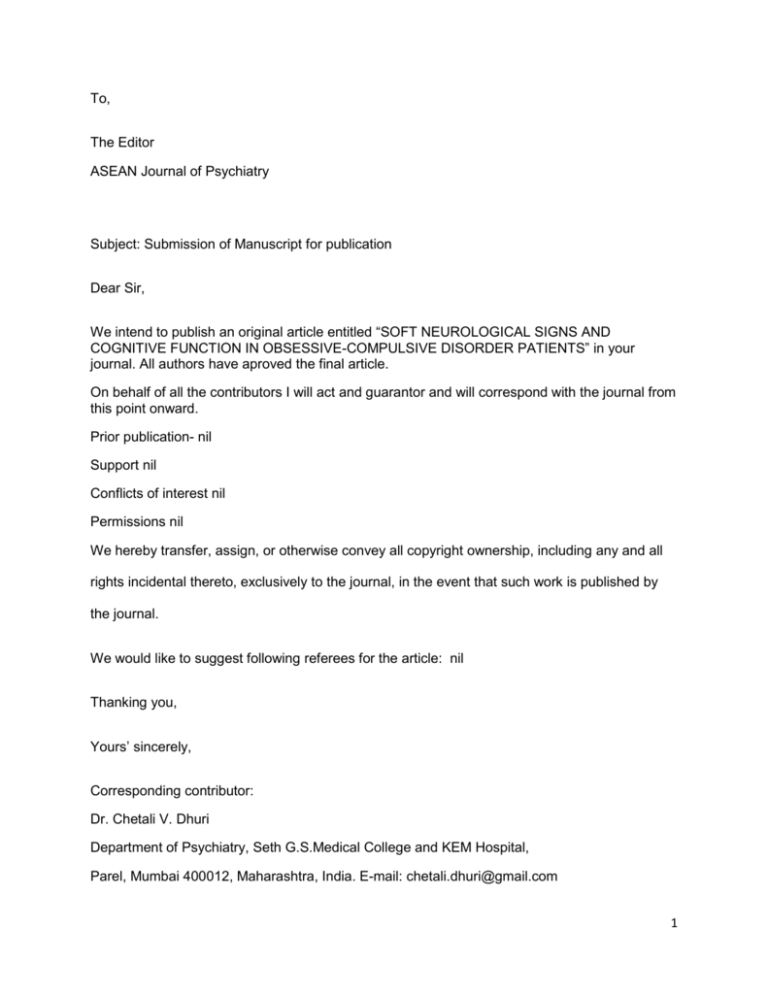
To, The Editor ASEAN Journal of Psychiatry Subject: Submission of Manuscript for publication Dear Sir, We intend to publish an original article entitled “SOFT NEUROLOGICAL SIGNS AND COGNITIVE FUNCTION IN OBSESSIVE-COMPULSIVE DISORDER PATIENTS” in your journal. All authors have aproved the final article. On behalf of all the contributors I will act and guarantor and will correspond with the journal from this point onward. Prior publication- nil Support nil Conflicts of interest nil Permissions nil We hereby transfer, assign, or otherwise convey all copyright ownership, including any and all rights incidental thereto, exclusively to the journal, in the event that such work is published by the journal. We would like to suggest following referees for the article: nil Thanking you, Yours’ sincerely, Corresponding contributor: Dr. Chetali V. Dhuri Department of Psychiatry, Seth G.S.Medical College and KEM Hospital, Parel, Mumbai 400012, Maharashtra, India. E-mail: chetali.dhuri@gmail.com 1 TYPE OF ARTICLE: ORIGINAL ARTICLE Title of the article: SOFT NEUROLOGICAL SIGNS AND COGNITIVE FUNCTION IN OBSESSIVE-COMPULSIVE DISORDER PATIENTS Contributors 1. Dr. Chetali V. Dhuri 2. Dr. Shubhangi R. Parkar Department(s) and institution(s): Department of Psychiatry, Seth G. S. Medical College and KEM Hospital, Parel, Mumbai, India Corresponding Author: Name: Dr. Chetali V. Dhuri Address: Department of Psychiatry, Seth G. S. Medical College and KEM Hospital, Parel, Mumbai 400012, Maharashtra, India. Phone number: 09833490089 E-mail address: chetali.dhuri@gmail.com Source(s) of support:Nil Presentation at a meeting: Nil Conflicting Interest (If present, give more details): Nil Acknowledgement: Nil 2 ABSTRACT Objective: Modern research on Obsessive-compulsive disorder (OCD) indicates that the primary cause of OCD, which was earlier explained only on basis of psychoanalytical theories is biological. Our study attempts to investigate the neurobiological signs in form of soft neurological signs and cognitive function in OCD. Methods: A cross sectional study among 50 OCD patients attending psychiatric facility of Seth G.S.Medical College and KEM hospital and age and education matched controls were selected for the study. Established instruments were used to assess the neurological soft signs and the cognitive deficits. Results: OCD patients had significant more neurological soft signs in tests for motor coordination, sensory integration, complex motor tasks, hard signs, right/left and spatial orientation. Cognitive deficits in the domains of visuospatial ability, executive function, attention and working memory were significantly more in OCD patients compared to controls. Conclusion: Our study highlights the role of biological factors in form of soft neurological signs, cognitive dysfunction in the development of the OCD. Key words: Obsessive compulsive disorder; Neurological soft signs, Cognitive function 3 INTRODUCTION In last two decades following advances in neuroimaging studies, there has been growing interest in studying the neurological soft signs (NSS) and cognitive function in obsessive compulsive disorder (OCD), a disorder which was earlier explained only on basis of psychoanalytical theories. Dysfunction in brain functioning implies that OCD should be characterized by neurological abnormalities which can be either ‘hard’ or ‘soft’. Hard signs refer to impairment in basic motor, sensory, and reflex behaviors. In contrast, NSS are described as non-localizing neurological abnormalities that cannot be related to impairment of a specific brain region or are not believed to be part of a welldefined neurological syndrome [1]. However, even if they are non-localizing, some NSS can suggest dysfunction in particular neural networks, and thus can give additional information concerning abnormalities in the functional organization that characterize some psychiatric diseases. Cognition denotes a relatively high level of processing of specific information including thinking, memory, perception, motivation, skilled movements and language. A constellation of these core cognitive deficits in various combinations and severity also have a role in the explaining the neuroanatomy and psychopathology of the disease [2, 3]. Efforts for assessment of NSS in OCD have met with variable success with some studies reporting significantly higher NSS in the domains of complex motor coordination, involuntary movements, mirror movements and primitive reflexes inpatients with OCD [4, 5]. However, there has been lack of consistency and specificity in the findings of the studies [6]. There is also growing evidence for cognitive dysfunction in OCD. Studies have reported impairment in visuospatial ability, executive function, attention, concentration and working memory in 4 OCD subjects [7, 8, 9, 10]. These deficits further lead to impairment in social and occupational functioning leading to increased distress and disability in OCD patients. Although western studies have looked at these issues, there are few studies from India investigating the role of NSS and cognitive deficits in adult OCD. MATERIALS & METHODS The study was conducted in outpatient department of Psychiatry in a tertiary care general public hospital, after obtaining the permission of the institutional review board. The study group comprised of 50 subjects with ICD-10 diagnosis of OCD, with age more than 18 years. Subjects with intellectual subnormality, organic mental disorders and spectrum of psychotic disorders (schizophrenia, schizoaffective disorder, bipolar disorder) as the major axis I disorder were excluded. The control group comprised of fifty subjects matched with study group for age and education with no past, present or family history of major psychiatric disorder in first degree relatives. All participants gave written informed consent to a protocol approved by the institutional review board. The NSS were assessed using Heidelberg soft neurological signs scale, a 16 item scale. A sufficient internal reliability and inter rater reliability has been established for this scale.11 It assess 5 factors: motor coordination (ozeretzki’s test, diadochokinesis, pronation –supination, finger-to-thumb opposition, speech articulation), sensory integration (gait, tandem walking, two-point discrimination), complex motor tests (fingerto-nose test, fist-edge-palm test), right/left and spatial orientation (right /left orientation, graphesthesia, face –hand test, stereognosis) and hard signs (includes arm holding test, mirror movements). 5 The cognitive function was assessed using the Montreal cognitive assessment for mild cognitive dysfunction.12 It is a one-page 30-point test. It assesses 6 cognitive domains: short-term memory recall task (two learning trials of five nouns and delayed recall after approximately 5 minute), visuospatial abilities (clock-drawing task and a threedimensional cube copy), executive functions (alternation , phonemic fluency ,verbal abstraction task), attention, concentration and working memory (sustained attention task, a serial subtraction, digits forward and backward), language (naming, repetition, aforementioned fluency task) and orientation to time and place. All analyses were performed with the statistical package for social sciences. Mann Whitney U test for comparison of mean between the study and control group. For correlational analyses, Pearson correlation (p) were run, p value less than 0.05 were taken as significant. RESULTS Socio-demographic variables The mean age of OCD subjects was 30.62 years with the range between 18-59 years. Amongst them 64% of the subjects were males. 56% of the subjects were college educated, 34% were up to secondary level, 6% were primary educated and 4% were illiterate. Table 1 about here Comparison of neurological soft signs 6 As revealed in the table 1, score were significantly higher in OCD subjects in all the tests for motor coordination (ozeretzki’s test, p=0.001; diadochokinesis, p <0.001; pronation-supination, p= 0.004; finger-to- thumb opposition, p <0.001; speech articulation, p <0.001), sensory integration (gait, p= 0.002; tandem walking, p < 0.001; two-point- discrimination, p <0.001), complex motor tasks (finger-to-nose test, p <0.001, fist-edge-palm-test, p<0.001) and hard signs (arm-holding test, p <0.001; mirror movements, p <0.001). OCD subjects scored significant higher in all the tests of right/left and spatial orientation (right/left orientation, p< 0.001; graphesthesia, p=0.007; sterognosis, p<0.001) except for test of sensory extinction (face-hand test, p =1.000). Table 2 about here Comparison of cognitive assessment for mild cognitive dysfunction As seen in the table 2, OCD patients fared worse on all subsets of Montreal cognitive assessment compared to controls. OCD patients showed significant deficits in short term memory task (p <0.001), visuospatial ability (p <0.001), executive function (p <0.001), attention, concentration and working memory (p <0.001), and language (p <0.001).There was no significant difference for orientation (p =0.53) between OCD patients and controls. Discussion NSS were present to a significantly greater extent in OCD patients than in controls in our study. These findings are in accordance with numerous prior studies reporting significantly higher total NSS scores in OCD subjects [4, 5, 13]. NSS in our OCD patients were significantly higher in all the subscales of motor coordination, sensory 7 integration, complex motor tests, right/left and spatial orientation and hard signs. Higher scores for motor coordination, complex motor tasks and hard signs seen here, are also reported by other studies [4, 5]. Though, the initial study by Hollander 1990 did not report higher scores in sensory integration and right left and spatial orientation but subsequent studies by Bolton 1998 and Guz 2004 and have reported higher scores also on these subtests as well. Bolton D 1998 also demonstrated that OCD subjects had neurological signs in certain categories like motor coordination, sensory integration, hard signs, tardive dyskinesia, catatonic and extrapyramidal signs similar to patients with schizophrenia. The significant impairment in cognition observed in our study in the domains of visuospatial ability, executive function, attention and working memory are in accordance to other studies. Visuospatial and visuoconstructional deficits in tests using ability to draw complex figures are the most consistent findings in OCD [7, 9]. Executive function deficits have also been reported in several studies among OCD patients [8, 14, 15]. OCD patients have shown impairment on both, verbal memory on measures of new learning such as the California verbal learning and non-verbal memory like visual reproduction and delayed recognition of figures [14, 16]. These findings may suggest impairment in encoding and retrieval of new information in OCD patient. Similarly, the finding of short term memory task deficit in this study may be explained on the above basis as well as the impaired attention seen in our patients. The observation of language deficit in our study needs further evaluation. Though, recent research has reported deficit in verbal fluency in OCD [17, 18]. There is scanty literature studying other language deficits such as repetition and naming. 8 The structural and functional imaging studies in OCD pathogenesis have identified dysfunctional fronto-striatal circuits [19, 20, 21, 22]. The orbitofrontal cortex and basal ganglia are the most consistently associated with OCD in imaging studies, OCD symptoms attributed to be caused by the hyperactive orbito-fronto-thalamic circuit [23]. These imaging findings are corroborated by the finding that disrupting connections between the OFC, ACC, thalamus, and basal ganglia by means of anterior capsulotomy or cingulotomy, results in a symptomatic improvement in most OCD patients [24, 25, 26]. Further OCD symptoms are reported damage to the basal ganglia, especially the caudate and the orbitofrontal cortex [27, 28]. Also, dysfunction of the basal ganglia secondary to a streptococcal infection [29] or encephalitis lethargic [30] has also been associated with the development of OCD. Though, NSS are described as non-localizing neurological abnormalities, neuroimaging studies have suggested associations of neurological soft signs with activation changes in the sensorimotor cortex, supplementary motor area, cerebellum, basal ganglia and thalamus [11, 31]. Similarly, the cognitive deficits namely visuospatial, executive, attention, concentration and memory observed in the study are indicative of the underlying neuroanatomical and neurophysiological changes, mainly in the frontal lobe. The presence of confounding factors such as comorbid depressive or psychotic symptoms is known to influence the NSS and cognition. However, study by Trivedi 2008 comparing OCD patients without any other comorbid axis I disorder with healthy controls reported significant impairment in executive function, sustained attention abilities and spatial working memory in OCD patients [32]. Similarly, Rao 2008 reported significant neuropsychological deficits in 30 recovered OCD patients in comparison with 9 30 matched healthy controls [33]. These findings are indicative that neuropsychological deficits are possibly state independent and are indicative of underlying neuroanatomical deficit. As this was a cross sectional study, the effect of therapeutic interventions on the scores of neurological soft signs and cognitive functions could not be assessed. CONCLUSION The presence of neurological soft signs and cognitive deficits in OCD are indicative of underlying neuroanatomical and neurophysiological dysfunction and that OCD is a brain disease. OCD affects the younger population and is known to cause significant impairment in individual social and occupational productivity. This disability can now be linked to the defective higher mental functions secondary to neurological dysfunction and not just the obsessive symptomatology as thought previously. REFERENCES 1. Heinrichs, DW and Buchanan, RW. Significance and meaning of neurological signs in schizophrenia. Am J Psychiatry 1988; 145: 11–18. 2. Braffand DL, Swerdlow NR Neuroanatomy of Schizophrenia. Schizophrenia Bulletin 1997; 23(3): 509-12. 3. Schmidtke K, Schorb A, Winkelmann G. Cognitive frontal lobe dysfunction in obsessive-compulsive disorder. Biological Psychiatry 1998; 43(9): 666-73. 4. Hollander E, Schiffman E, Cohen B, Rivera-Stein MA, Rosen W, Gorman JM, et al. Signs of central nervous system dysfunction in obsessive-compulsive disorder. Arch Gen Psychiatry 1990; 47: 27-32. 10 5. Bolton D, Gibb W, Lees A, Raven P, Gray JA, Chen E, et al. Neurological soft signs in obsessive compulsive disorder: standardized assessment and comparison with schizophrenia. Behav Neurol 1998; 11: 197-204. 6. Stein DJ, Hollander E, Simeon D, Cohen L, Islam MN, Aronowitz B. Neurological soft signs in female trichotillomania patients, obsessive-compulsive disorder patients, and healthy control subjects. J Neuropsychiatry Clin Neurosci 1994; 6: 184-7. 7. Christensen KJ, Kim SW, Dysken MW, et al. Neuropsycho¬logical performance in obsessive-compulsive disorder. Biol Psychiatry 1992; 31: 4-18. 8. Savage CR, Baer L, Keuthen NJ, et al. Organizational strategies mediate non-verbal memory impairment in obsessive- compulsive disorder. Biol Psychiatry 1999; 45: 90516. 9. Okasha A, Rafaat M, Mahallawy N, et al. Cognitive dysfunction in obsessivecompulsive disorder. Acta Psychiatr Scand 2000; 101: 281-5. 10. Deckersbach T, Savage CR, Curran T, et al. A study of parallel implicit and explicit information processing in obsessive- compulsive disorder. Am J Psychiatry 2002; 159: 1780-2. 11. Schroder J, Niethammer R, Geider FJ, Reitz C, Binkert M, Jauss M, Sauer H. Neurological soft signs in schizophrenia. Schizophrenia Research 1992; 6: 25–30. 12. Nasreddine ZS, Phillips NA, Beédirian V, et al. The Montreal Cognitive Assessment, MoCA: A brief screening tool for mild cognitive impairment. J Am Geriatr Soc. 2005; 53: 695–699. 11 13. Guz H, Aygun D. Neurological soft signs in obsessive-compulsive disorder Neurol India 2004; 52: 72-5. 14. Aronowitz BR, Hollander E, DeCaria C, et al. Neuropsychology obsessivecompulsive disorder: Preliminary findings. Neuro¬psychiatr Neuropsychol Behav Neurol 1994; 7: 81-6. 15. Dirson S, Bouvard M, Cottraux J, et al. Visual memory impairment in patients with obsessive-compulsive disorder: A controlled study. Psychother Psychosom 1995; 63:22-31. 16. Cohen LJ, Hollander E, DeCaria CM, et al. Specificity of neuropsychological impairment in obsessive-compulsive disorder. J Neuropsychiatry Clin Neurosci 1996; 8: 99-103. 17. Boldrini M, Pace LD, Placidi GPA, et al. Selective cognitive deficits in obsessivecompulsive disorder compared to panic disorder with agoraphobia. Acta Psychiatrica Scandinavica 2005; 111(2): 150–158. 18. Henry JD. A meta-analytic review of Wisconsin Card Sorting Test and verbal fluency performance in obsessive-compulsive disorder. Cogn Neuropsychiatry 2006 Mar; 11(2): 156-76. 19. Modell JG, Mountz JM, Curtis GC, et al. Neurophysiologic dysfunction in basal ganglia/limbic striatal and thalamocortical circuits as a pathogenetic mechanism of obsessive-compulsive disorder. J Neuropsychiatry Clin Neurosci 1989; 1: 27–36. 12 20. Insel TR. Toward a neuroanatomy of obsessive-compulsive disorder. Arch Gen Psychiatry 1992; 49: 739–744. 21. Schwartz JM. A role of volition and attention in the generation of new brain circuitry: toward a neurobiology of mental force. J Consciousness Stud 1999; 6: 115–142. 22. Deckersbach T, Dougherty DD, Rauch SL. Functional imaging of mood and anxiety disorders. J Neuroimaging 2006; 16: 1–10. 23. Whiteside SP, Port JD, Abramowitz JS. A meta-analysis of functional neuroimaging in obsessive-compulsive disorder. Psychiatry Res 2004; 132: 69–79. 24. Jenike MA. Neurosurgical treatment of obsessive-compulsive disorder. Br J Psychiatry Suppl 1998; 35: 79–90. 25. Binder DK, Iskandar BJ. Modern neurosurgery for psychiatric disorders. Neurosurgery 2000; 47: 9–23. 26. Greenberg BD, Price LH, Rauch SL, et al. Neurosurgery for intractable obsessivecompulsive disorder and depression: critical issues. Neurosurg Clin N Am 2003; 14: 199–212. 27. Berthier ML, Kulisevsky J, Gironell A, et al. Obsessive-compulsive disorder associated with brain lesions: clinical phenomenology, cognitive function, and anatomic correlates. Neurology 1996; 47: 353–361. 28. Carmin CN, Wiegartz PS, Yunus U, et al. Treatment of late-onset OCD following basal ganglia infarct. Depress Anxiety 2002; 15: 87–90. 13 29. Swedo SE, Leonard HL, Garvey M, et al. Pediatric autoimmune neuropsychiatric disorders associated with streptococcal infections: clinical description of the first 50 cases. Am J Psychiatry 1998; 155: 264–271. 30. Caparros- Lefebvre D, Cabaret M, Godefroy O, et al. PET study and neuropsychological assessment of a long-lasting post-encephalitic parkinsonism. J Neural Transm 1998; 105: 489–495. 31. Keshavan MS, Sanders RD, Sweeney JA, Diwadkar VA, Goldstein G, Pettegrew JW, Schooler NR. Diagnostic specificity and neuroanatomical validity of neurological abnormalities in first-episode psychoses. Am J Psychiatry 2003; 160: 1298–1304. 32. Trivedi JK, Sharma S, Tandon R, et al. Neurocognitive dysfunction in the patients with obsessive compulsive disorder. Afr J of Psychiatry 2008; 11: 204-209. 33. Naren P Rao, Y C Janardhan Reddy, Keshav J Kumar, et al. Are neuropsychological deficits trait markers in OCD? Progress in NeuroPsychopharmacology and Biological psychiatry 2008; 32(6): 1574-1579. 14 Table 1: Comparison of neurological soft signs Gait Tandem walking Right / left orientation Arm-holding test Finger-to-nose test Ozeretzki's test Diadochokinesis Pronation-supination Finger-to-thumb opposition Mirror movements Two-point-discrimination Graphesthesia Group Mean Std. Deviation p value Study 0.32 0.587 0.002 Control 0.04 0.198 Study 0.38 0.490 Control 0.02 0.141 Study 0.96 0.968 Control 0.02 0.141 Study 0.92 0.665 Control 0.04 0.198 Study 0.82 0.825 Control 0.00 0.000 Study 1.52 0.646 Control 1.02 0.654 Study 0.96 0.727 Control 0.46 0.579 Study 0.24 0.517 Control 0.02 0.141 Study 0.50 0.614 Control 0.00 0.000 Study 0.74 0.600 Control 0.00 0.000 Study 0.22 0.418 Control 0.00 0.000 Study 0.30 0.614 Control 0.04 0.198 <0.001* <0.001* <0.001* <0.001* 0.001 <0.001* 0.004 <0.001* <0.001* <0.001* 0.007 15 Face-hand test Stereognosis Fist-edge-palm- test Speech and articulation Total score (Mann Whitney U test) Study 0.02 0.141 Control 0.02 0.141 Study 0.38 0.530 Control 0.06 0.240 Study 1.34 0.772 Control 0.22 0.465 Study 0.60 0.606 Control 0.02 0.141 Study 10.22 0.606 Control 1.98 0.141 1.000 <0.001* <0.001* <0.001* <0.001* (p < 0.05 - Significant) (* - p < 0.001- Highly significant) 16 Table 2: Comparison of cognitive assessment for mild cognitive dysfunction Domains Group Mean Std. Deviation p value Short term memory task Study 3.72 1.278 <0.001* Control 4.54 0.579 Study 2.02 1.059 Control 3.20 1.107 Study 2.28 0.607 Control 2.86 0.833 Study 3.46 1.528 Control 4.80 1.429 Study 4.26 0.803 Control 4.84 0.422 Study 5.66 0.745 Control 5.76 0.591 Study 21.84 3.466 Control 26.40 3.232 Visuospatial ability Executive function <0.001* <0.001* Attention, Concentration <0.001* and Working memory Language Orientation Total score (Mann Whitney U test) <0.001* 0.573 <0.001* (p < 0.05 - Significant) (* - p < 0.001- Highly significant) 17

